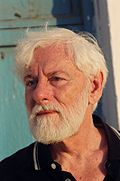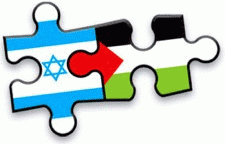"THE TWO-STATE solution is dead!" This mantra has been repeated so often lately, by so many authoritative commentators, that it must be true.
Well, it ain't.
It reminds one of Mark Twain's oft quoted words: "The report of my death was an exaggeration."
BY NOW this has become an intellectual fad. To advocate the two-state solution means that you are ancient, old-fashioned, stale, stodgy, a fossil from a bygone era. Hoisting the flag of the "one-state solution" means that you are young, forward-looking, "cool."
Actually, this only shows how ideas move in circles. When we declared in early 1949, just after the end of the first Israeli-Arab war, that the only answer to the new situation was the establishment of a Palestinian state side by side with Israel, the "one-state solution" was already old.
The idea of a "bi-national state" was in vogue in the 1930s. Its main advocates were well-meaning intellectuals, many of them luminaries of the new Hebrew University, like Judah Leon Magnes and Martin Buber. They were reinforced by the Hashomer Hatza'ir kibbutz movement, which later became the Mapam party.
It never gained any traction. The Arabs believed that it was a Jewish trick. Bi-nationalism was built on the principle of parity between the two populations in Palestine -- 50% Jews, 50% Arabs. Since the Jews at that time were much less than half the population, Arab suspicions were reasonable.
On the Jewish side, the idea looked ridiculous. The very essence of Zionism was to have a state where Jews would be masters of their fate, preferably in all of Palestine.
At the time, no one called it the "one-state solution" because there was already one state -- the State of Palestine, ruled by the British. The "solution" was called "the bi-national state" and died, unmourned, in the war of 1948.
WHAT HAS caused the miraculous resurrection of this idea?
Not the birth of a new love between the two peoples. Such a phenomenon would have been wonderful, even miraculous. If Israelis and Palestinians had discovered their common values, the common roots of their history and languages, their common love for this country -- why, wouldn't that have been absolutely splendid?
But, alas, the renewed "one-state solution" was not born of another immaculate conception. Its father is the occupation, its mother despair.
The occupation has already created a de facto One State -- an evil state of oppression and brutality, in which half the population (or slightly less than half) deprives the other half of almost all rights -- human rights, economic rights and political rights. The Jewish settlements proliferate, and every day brings new stories of woe.
Good people on both sides have lost hope. But hopelessness does not stir to action. It fosters resignation.
LET'S GO back to the starting point. "The two-state solution is dead." How come? Who says? In accordance with what scientific criteria has death been certified?
Generally, the spread of the settlements is cited as the sign of death. In the 1980s the respected Israeli historian Meron Benvenisti pronounced that the situation had now become "irreversible." At the time, there were hardly 100 thousand settlers in the occupied territories (apart from East Jerusalem, which by common consent is a separate issue). Now they claim to be 300 thousand, but who is counting? How many settlers mean irreversibility? 100, 300, 500, 800 thousand?
(Note: You can view every article as one long page if you sign up as an Advocate Member, or higher).






